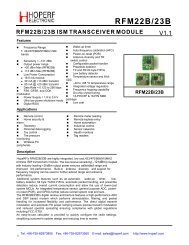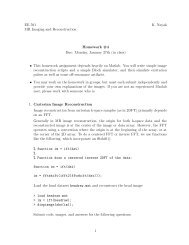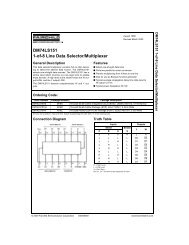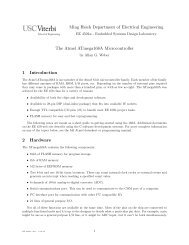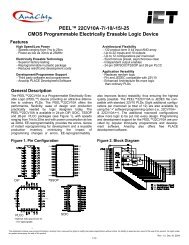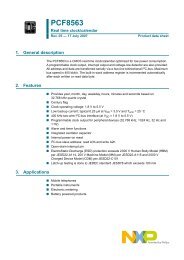Ming Hsieh Department of Electrical Engineering Programming the ...
Ming Hsieh Department of Electrical Engineering Programming the ...
Ming Hsieh Department of Electrical Engineering Programming the ...
Create successful ePaper yourself
Turn your PDF publications into a flip-book with our unique Google optimized e-Paper software.
5.15 Code Optimization<br />
A good reference on optimizing C programs for <strong>the</strong> HC08 processors is Freescale’s application note AN2093<br />
which is available on <strong>the</strong> class web site. The information below summarizes much <strong>of</strong> what is contained in<br />
that document.<br />
As stated above, always use <strong>the</strong> smallest variable possible. Don’t use a 16-bit “int” if a 8-bit “char” or<br />
“byte” will work. The processor does all arithmetic operations eight bits at a time so using a 16-bit value<br />
can more than double <strong>the</strong> amount <strong>of</strong> work needed to do calculations.<br />
When implementing loops, if possible make <strong>the</strong> loop index count down to zero ra<strong>the</strong>r than counting up<br />
to some number. The processor is more efficient at checking for a zero value than doing compares against<br />
a non-zero value. If a loop is always going to be performed <strong>the</strong> same small number <strong>of</strong> times, consider<br />
“unrolling” <strong>the</strong> loop and simply repeating <strong>the</strong> instructions <strong>the</strong> required number <strong>of</strong> times.<br />
Make use <strong>of</strong> <strong>the</strong> direct page RAM location when storing values that will be accessed <strong>of</strong>ten. Some<br />
instructions only work with direct page addresses and in general access time to direct page locations is<br />
significantly faster than for those requiring a 16-bit address.<br />
Do not use complex data structures. Referencing elements <strong>of</strong> a data structure <strong>of</strong>ten require doing multiplications<br />
to find <strong>the</strong> proper element and this can be very slow on an 8-bit processor. It’s better to instead<br />
use multiple one-dimensional arrays <strong>of</strong> a simple data type.<br />
Different #pragma statements can be used to tell <strong>the</strong> compiler how to handle translation <strong>of</strong> certain<br />
functions. A list <strong>of</strong> <strong>the</strong>se pragmas can be found starting at page 355 <strong>of</strong> <strong>the</strong> Compiler Manual.<br />
6 The PRM File<br />
The PRM file controls where procedures and data are put in memory. It defines “SEGMENTS” which<br />
identify portions <strong>of</strong> memory and your code and variables can be placed in those segments. One or more code<br />
segments and data segments are defined to cover <strong>the</strong> areas supported by <strong>the</strong> microcontroller (0x60-0x25F for<br />
data and 0xBC00 - 0xFBFF for code). The example below from a PRM file defines two areas for variables<br />
(Z RAM and RAM) and one for code (ROM). The “Z RAM” segment covers <strong>the</strong> range 0x60 to 0xff where<br />
data can be accessed using only an 8-bit address. The remainder <strong>of</strong> <strong>the</strong> RAM area (0x100 to 0x25f) is<br />
covered by <strong>the</strong> “RAM” segment. The ROM segment starts at 0xBC00 and all <strong>the</strong> program code is stored<br />
<strong>the</strong>re.<br />
/* Here all RAM / ROM areas are listed . Used in PLACEMENT below . */<br />
SEGMENTS<br />
Z_RAM = READ_WRITE 0 x0060 TO 0 x00FF ;<br />
RAM = READ_WRITE 0 x0100 TO 0 x025F ;<br />
ROM = READ_ONLY 0 xBC00 TO 0 xFBFF ;<br />
END<br />
/* Here all predefined and users segments are placed<br />
into <strong>the</strong> SEGMENTS defined above . */<br />
PLACEMENT<br />
DEFAULT_RAM , INTO RAM /* non - zero page variables */<br />
PRESTART , /* startup code */<br />
STARTUP , /* startup data structures */<br />
STRINGS , /* string literals */<br />
DEFAULT_ROM INTO ROM ;<br />
_DATA_ZEROPAGE ,<br />
MY_ZEROPAGE INTO Z_RAM ; /* zero page variables */<br />
END<br />
The “PLACEMENT” section <strong>of</strong> <strong>the</strong> PRM file defines <strong>the</strong> names are associated with each segment. In<br />
your C code you can use <strong>the</strong> “#pragma” statements to indicate which segment code should be placed into<br />
(see <strong>the</strong> examples). It is probably a good idea just to use <strong>the</strong> example as a template for your PRM file and<br />
EE 459Lx, Rev. 5/29/13 12



